Key takeaways:
- Practical effects evoke genuine reactions and enhance storytelling, creating a tangible connection for both actors and audiences.
- Collaboration, adaptability, and safety are crucial during the planning and implementation of practical effects on set.
- Types of practical effects, such as animatronics, makeup, and miniatures, showcase the artistry and skill involved in creating memorable cinematic experiences.
- Testing effects on a small scale and collaborating with the cinematographer can significantly improve the visual impact of practical effects.
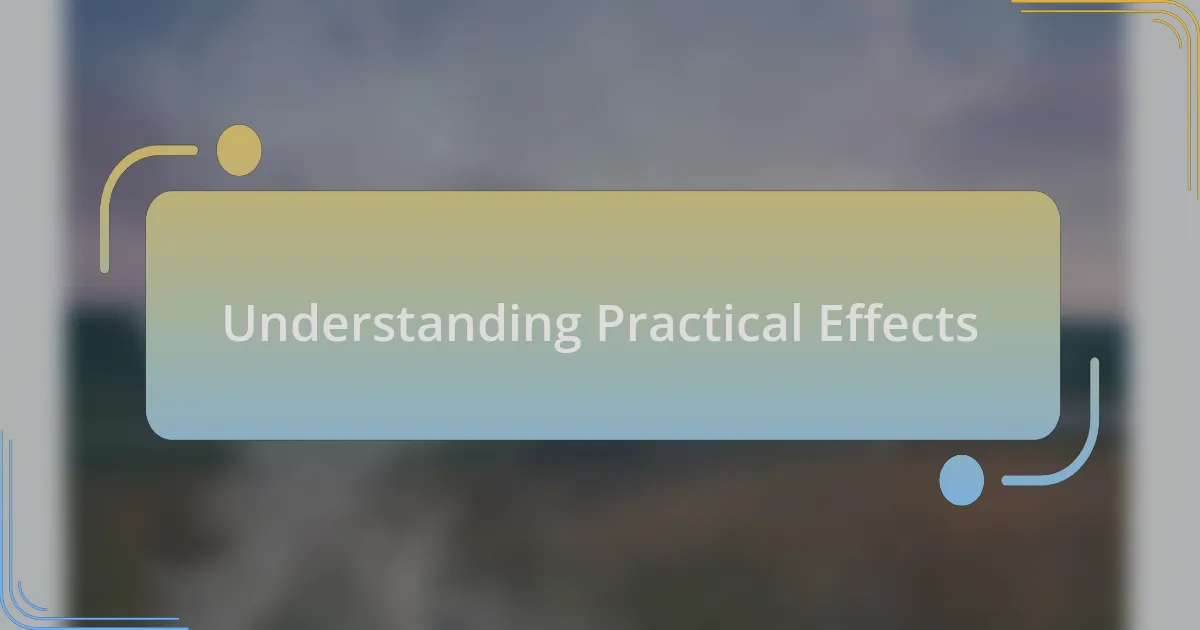
Understanding Practical Effects
Practical effects are tangible, hands-on techniques used in film to create illusions of reality, often in stark contrast to CGI. I remember the first time I witnessed how a simple water tank could convincingly simulate a stormy sea while filming a scene. The magic of practical effects lies in their ability to evoke genuine reactions from actors and audiences alike – there’s something about an actual explosion or a physically crafted creature that immerses you in the moment.
What truly fascinates me about practical effects is the artistry involved. Unlike digital effects, which can be easily altered, creating a practical effect requires meticulous planning and craftsmanship. I once worked on a project where we built a life-sized animatronic creature. Seeing it come to life for the first time was an emotional experience, reminding me of the dedication and creativity that goes into every detail. Isn’t it incredible how a team’s collective effort can shape the viewer’s experience?
Moreover, practical effects have a lasting impact on storytelling. When an actor interacts with a physically present effect, the authenticity can deepen their performance. Have you ever noticed how much more visceral a physical stunt can feel compared to a computer-generated alternative? This connection is what draws me back to practical effects; they are a reminder of the tactile nature of filmmaking that can sometimes get lost in an increasingly digital world.
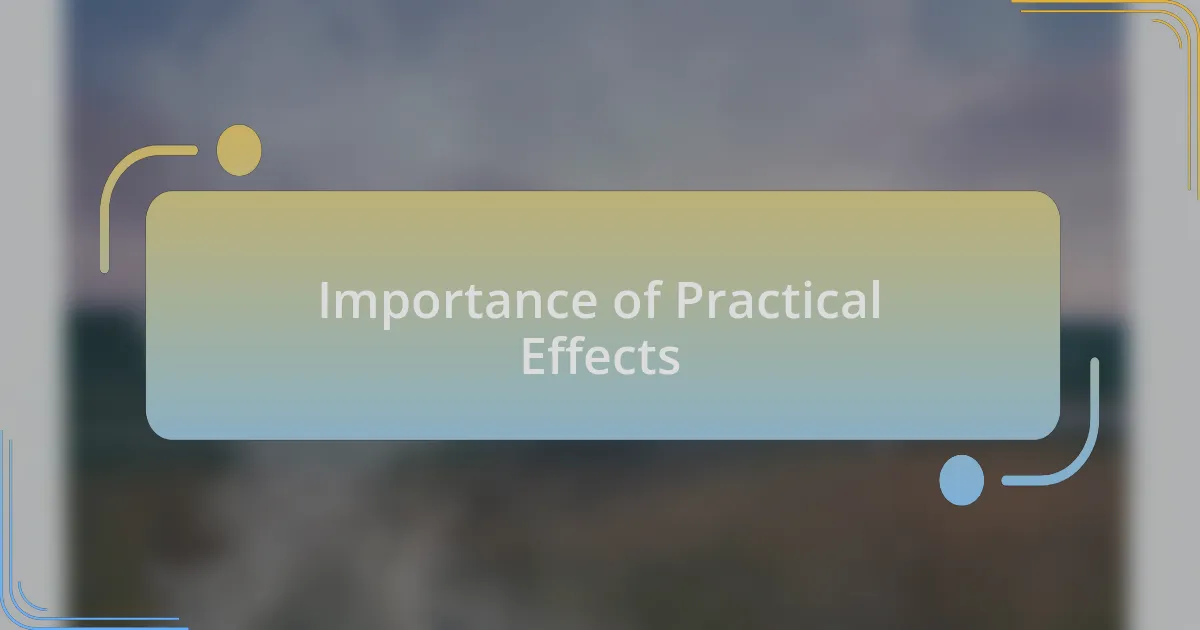
Importance of Practical Effects
The importance of practical effects in filmmaking cannot be overstated. I remember a time when we crafted a massive explosion using pyrotechnics on set. The energy was palpable, and the actors’ genuine reactions added an authenticity to the scene that would be hard to replicate with CGI. Have you ever felt your heart race during a scene where you knew the danger was real? That’s the power of practical effects.
They reinforce the physicality of a scene in a way that taps into our emotions. I once observed an actor perform a stunt next to a real, life-sized car crash we had staged. The adrenaline in the air was electric, making their performance feel all the more real and engaging. Can you recall a moment in a film where the reality of the situation transported you right into the heart of the action? It’s moments like these that make practical effects so integral to storytelling.
Additionally, practical effects resonate with viewers on an instinctive level. They remind us that the world we’re seeing, no matter how fantastical, is grounded in a tangible reality. When I see a well-crafted creature or an intricate set piece, it sparks my imagination in a way that digital effects sometimes fail to do. Isn’t it fascinating how a physical object can create a lasting memory, while digital effects might fade away as just pixels on a screen?
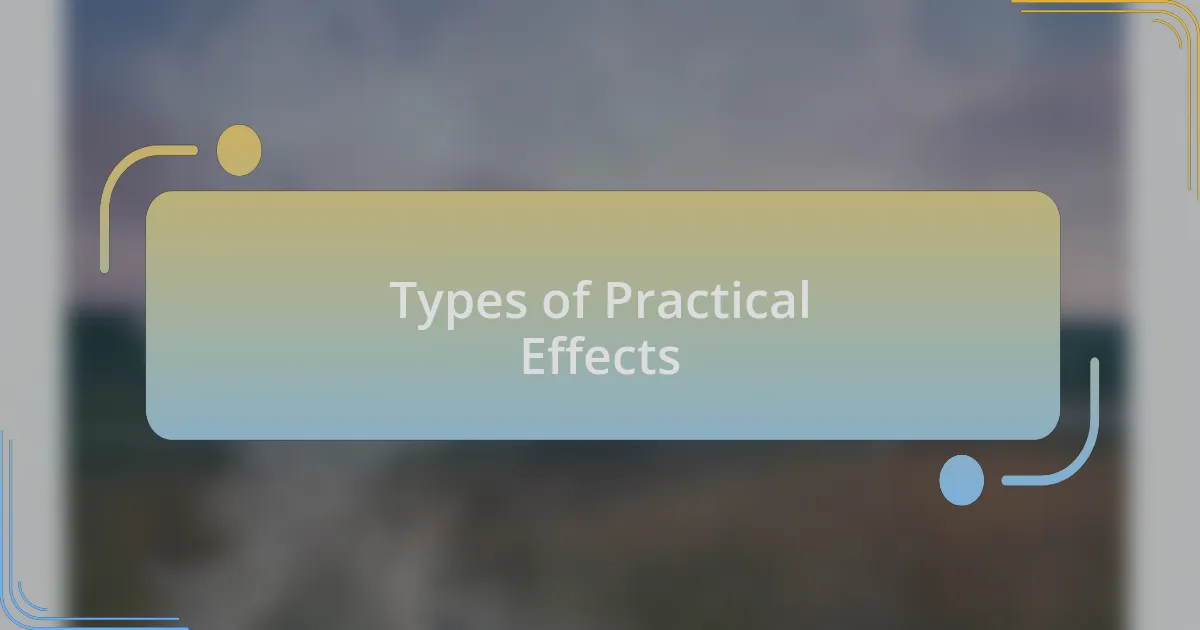
Types of Practical Effects
When discussing types of practical effects, I find it fascinating to think about the versatility they bring. Take animatronics, for instance. I once worked on a project where we used a complex animatronic creature to create tension; the combination of mechanical movement and realistic design made it feel alive. Have you ever witnessed something that seemed so real it sent shivers down your spine? That’s the magic of animatronics.
Another compelling type of practical effect is makeup and prosthetics. I recall a scene in a horror film I was involved in, where our makeup artist transformed an actor into a grotesque monster using prosthetics. The actor’s commitment to their role was palpable, and the audience’s reaction was proof of the fear that authenticity can elicit. Can you imagine how different that scene would have felt without those physical transformations?
Lastly, let’s consider miniatures. In one of my favorite films, they used detailed miniatures for destruction sequences. Seeing those intricately crafted models being filmed with real explosions was exhilarating. It made me reflect on the level of artistry and skill involved in creating such meticulous work. Have you ever been captivated by the sheer creativity it takes to bring tiny worlds to life in a way that feels grand? That’s the charm of miniatures in film.
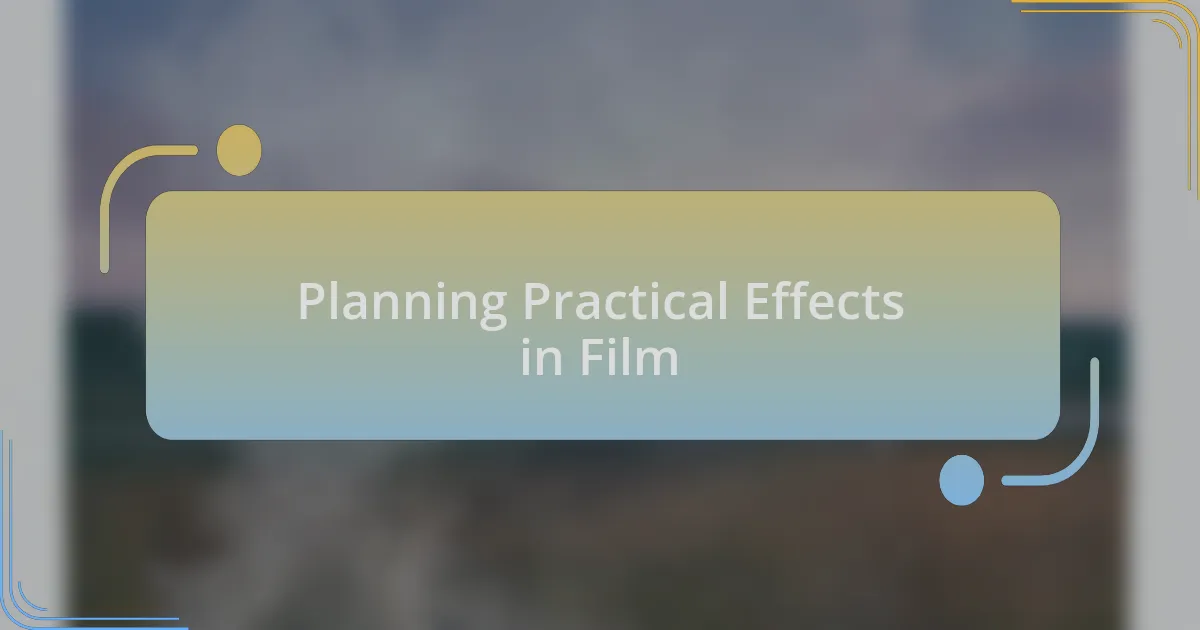
Planning Practical Effects in Film
When I plan practical effects for a film, I always begin by sketching out the vision alongside the director. During the pre-production meetings, I often share my thoughts on how specific effects can enhance storytelling. Once, in a brainstorming session, we discussed a pivotal scene where a character’s emotional journey would be highlighted with environmental effects like fog and rain. How much more impactful do you think that moment would feel when the audience can see and feel the atmosphere?
Budgeting is another key aspect I consider while planning. It’s crucial to balance creativity with cost. I remember a project where we needed a realistic explosion on a tight budget. We opted for a combination of practical pyrotechnics and visual effects, allowing us to maintain authenticity without overspending. Have you ever been in a situation where resource constraints pushed your creativity to new heights?
Finally, I believe that timing is everything when planning practical effects. For one film, we scheduled effects tests weeks before shooting to ensure everything worked seamlessly. The excitement in those test runs, seeing ideas come to life before the actual filming, is unrivaled. It made me wonder: what could we achieve if every production invested that time in practical pre-visualization?
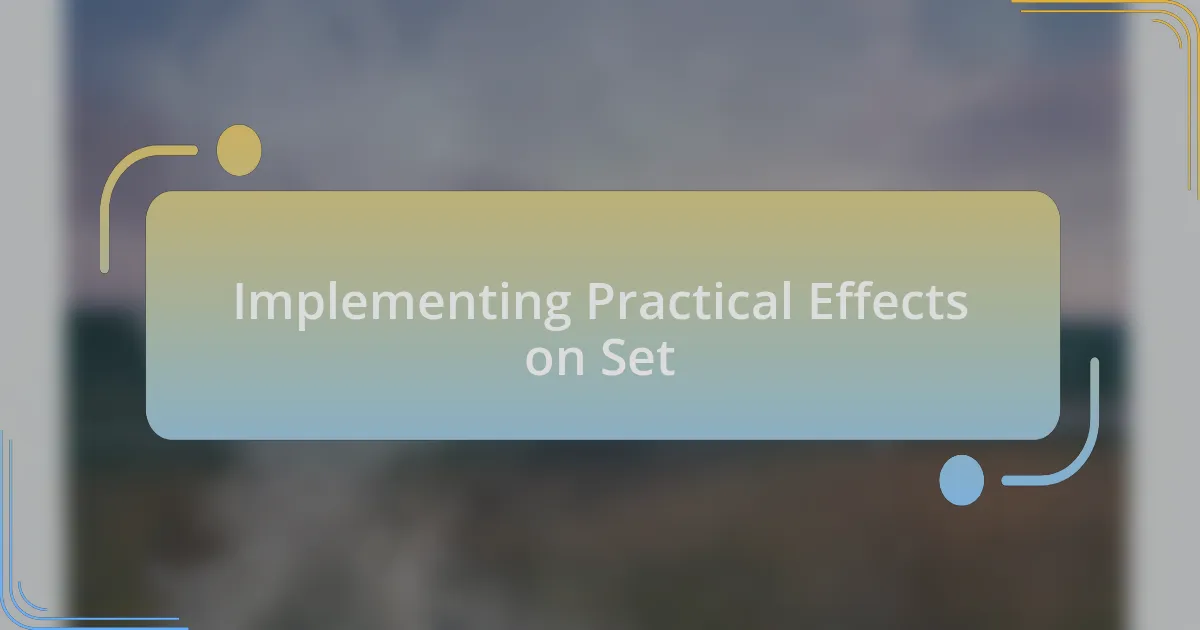
Implementing Practical Effects on Set
When I’m on set, implementing practical effects requires collaboration among the crew. I recall a day shooting a suspenseful thriller; we had a smoke machine ready for a climactic reveal. The moment the fog rolled in, I felt a wave of excitement—suddenly, the atmosphere shifted, heightening the tension and pulling the audience into the scene. Isn’t it remarkable how a physical element like smoke can transform a shot?
Moreover, I’ve learned that adaptability is essential during filming. There was an instance when a mechanical creature we planned to use malfunctioned just hours before we started shooting. Instead of panicking, we quickly pivoted and utilized a puppet version of the creature—the energy on set was electric as we improvised. How often do we find that a last-minute change can lead to unexpected creativity?
Safety is also a top priority when dealing with practical effects. I always conduct thorough safety briefings with the crew, especially when we’re working with fire or heavy props. During one shoot, I instituted a ‘safety zone’ around pyrotechnics, which not only ensured everyone’s well-being but also created an environment where the team felt comfortable and secure. Don’t you agree that a safe set fosters not just productivity but also creativity?
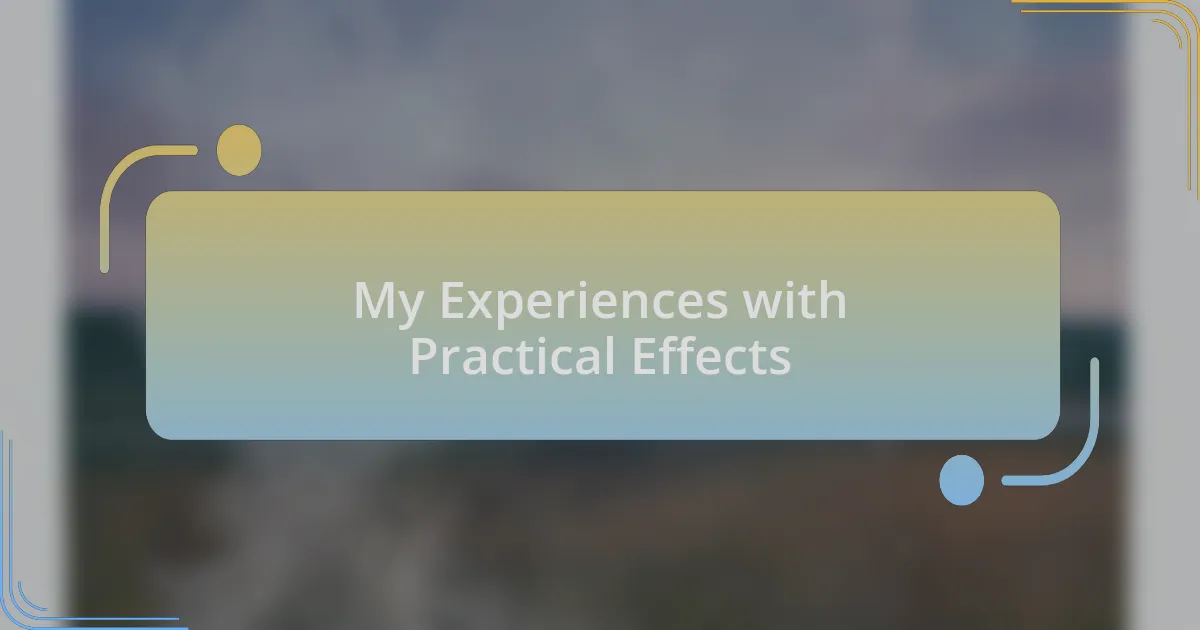
My Experiences with Practical Effects
While working on an indie horror film, I vividly remember wrestling with the challenge of creating realistic blood effects. It was exhilarating to experiment with different recipes in the makeup department, creating a concoction that looked authentic yet was safe for actors. When we splattered that final mix on the wall during the scene, I felt a surge of adrenaline—instantly, the tension in the air shifted, and I knew we had achieved the eerie effect we were aiming for.
During another shoot, I decided to incorporate a practical explosion for a key action sequence instead of relying solely on CGI. Seeing it unfold live was nothing short of mesmerizing. I could feel the ground shake beneath me, and the expressions of my cast members turned from excitement to pure awe. Isn’t there something special about witnessing the power of tangible effects in real time?
In my early days, I underestimated the impact of lighting on practical effects. There was a moment when a foggy scene didn’t pop quite right, leading to frustration for everyone involved. That experience taught me the vital role lighting plays in enhancing what is already there. Do you think lighting can elevate the simplest practical effects into something unforgettable? For me, that realization transformed how I approach each project, ensuring I always consider every aspect of the scene.
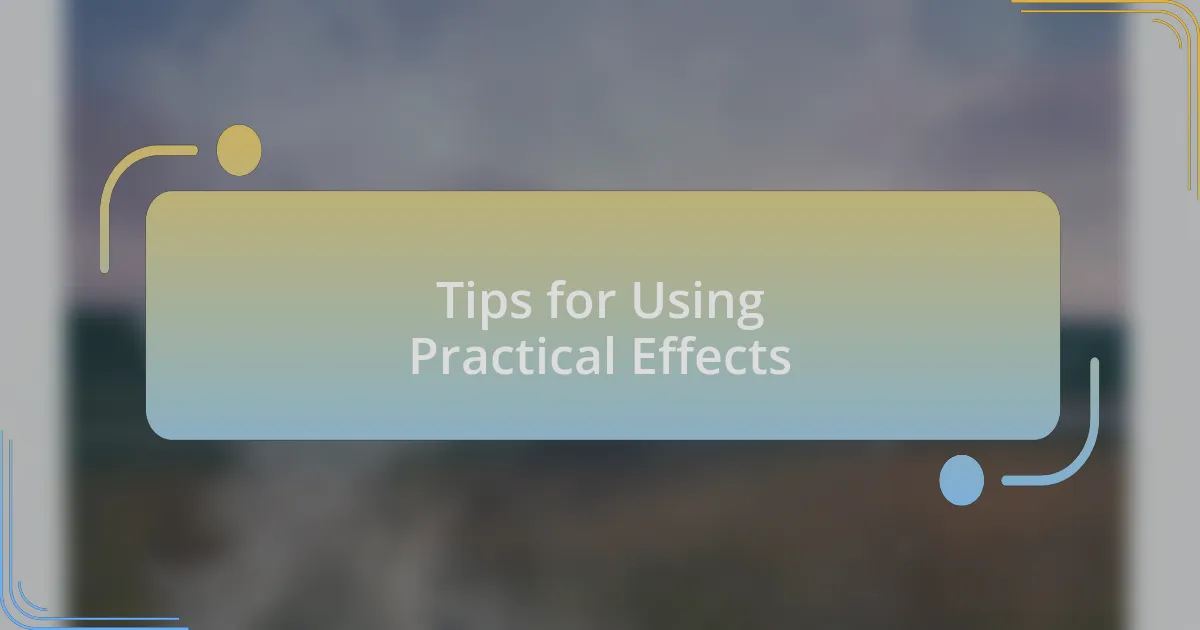
Tips for Using Practical Effects
When using practical effects, always test small-scale versions before going all in. I remember we wanted to create a scream-inducing creature effect, so we did a mini demo with various materials. The moment the team saw it come to life, we knew we were on the right track, but that initial trial saved us from a potentially costly mistake on set.
Another tip I find invaluable is to collaborate closely with your cinematographer. During one project, my initial vision of a blood splatter didn’t translate well on camera. By discussing angles and lighting before the shoot, we adjusted the effect for maximum impact. Have you ever made the mistake of not considering the camera’s perspective? That conversation significantly altered our approach, leading to a final product that elevated the entire scene.
Don’t underestimate the power of sound design when showcasing practical effects. One time, we had this incredible explosion sequence, but it fell flat until we layered in rich sound effects that made it punchier. Isn’t it amazing how sound breathes life into visuals? Now, I always think about the harmony between what’s seen and what’s heard, creating an immersive experience for the audience.